1970s
Beauty Knows No Pain
A species of Independence Day-style patriotism--I guess.
You will learn of this miraculous slogan around the 11-minute mark.
The Wikipedia page.
Posted By: Paul - Sun Jul 04, 2021 -
Comments (1)
Category: Beauty, Ugliness and Other Aesthetic Issues, Regionalism, Sports, Sex Symbols, 1970s, Attractiveness, Sexiness, Allure and Personal Magnetism
Sesame Street Fever
The Wikipedia page
Posted By: Paul - Tue Jun 29, 2021 -
Comments (1)
Category: Fads, Music, Television, Children, 1970s
Company seeks frozen sparrows
1978: The Taiei Company of Japan contacted the U.S. State Department seeking an American company willing to provide it with frozen sparrows "at regular intervals". The company was ready to "give guidance on how to catch small birds and how to process them".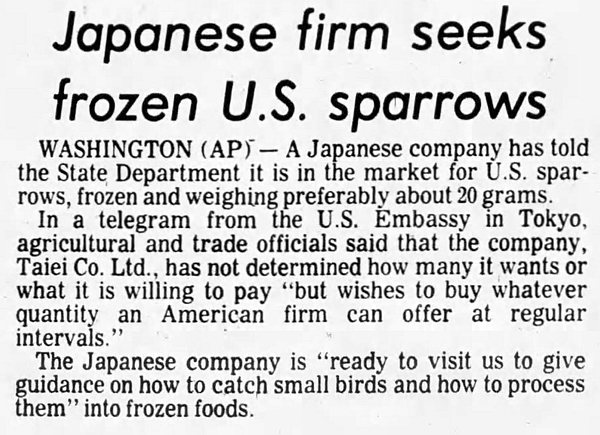
Bangor Daily News - Jan 14, 1978
According to the British Food History site, sparrows used to be a common part of the British diet.
Posted By: Alex - Mon Jun 28, 2021 -
Comments (2)
Category: Animals, Food, 1970s
Battle of the Amazons
Maybe the popularity of the WONDER WOMAN films will cause this gem to be reissued.The IMDB page.
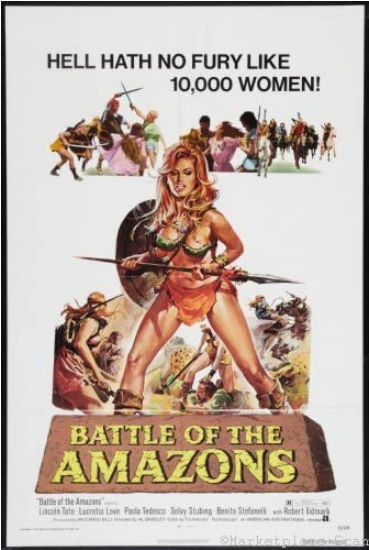
Posted By: Paul - Sat Jun 26, 2021 -
Comments (1)
Category: History, Ineptness, Crudity, Talentlessness, Kitsch, and Bad Art, Movies, 1970s, Women
Boar Mate

Miami Herald - Jun 08, 1979
It's available for purchase here.

Posted By: Alex - Sat Jun 12, 2021 -
Comments (2)
Category: Animals, 1970s, Attractiveness, Sexiness, Allure and Personal Magnetism
Pythagoron
Released in 1977, the album Pythagoron consisted of electronic sounds that supposedly stimulated certain brain waves, thereby allowing the listener to get high, without the use of drugs. The Hum blog offers more details:The album is intended to get the listener high – the aural mirror to Brion Gysin’s Dream Machines, and the step beyond La Monte Young. Capitalizing on the the tonal precision allowed by synthesizers – it attempts to harness the resonant interaction of sound and brainwave patterns to induce states of euphoria – the precursor of more recent efforts in binaural beats and neural oscillation.
Posted By: Alex - Fri Jun 11, 2021 -
Comments (1)
Category: Drugs, Psychedelic, Music, 1970s
Uglies Unlimited
Uglies Unlimited was founded by Danny McCrory in 1973. Its purpose was to promote the rights of ugly people. As far as I can tell, it remained in existence for only about a year.Seems ironic that the member the media chose to focus on (below) was obviously attractive.
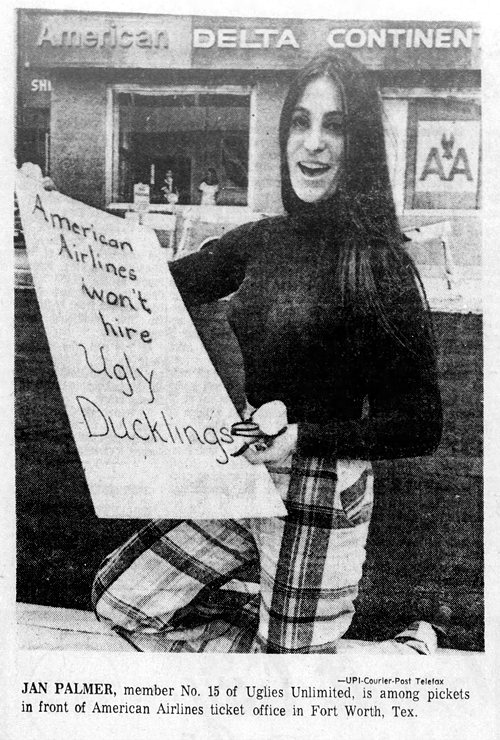
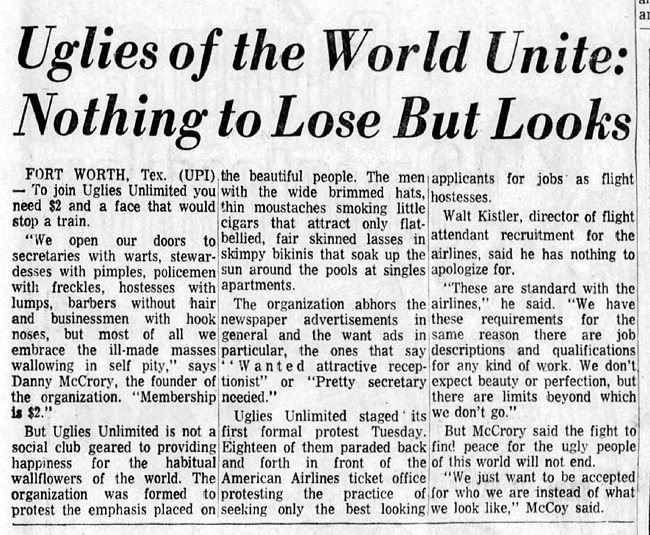
Camden Courier-Post - Nov 14, 1973
Posted By: Alex - Wed Jun 09, 2021 -
Comments (4)
Category: Beauty, Ugliness and Other Aesthetic Issues, Clubs, Fraternities and Other Self-selecting Organizations, 1970s
Fake Disco Moves

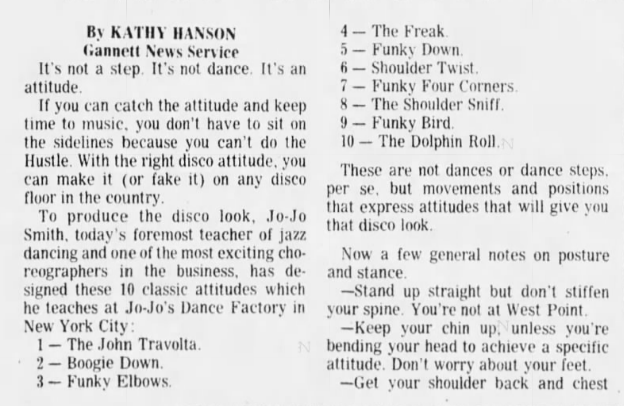
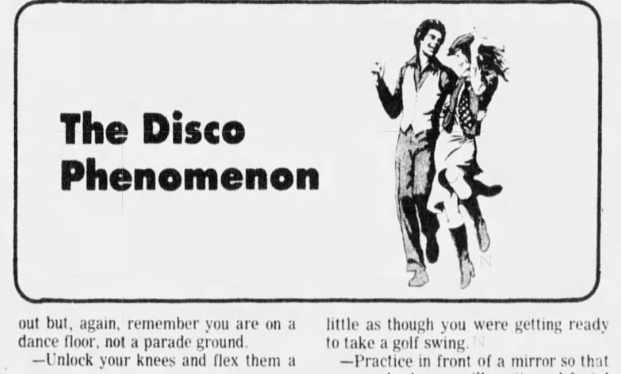
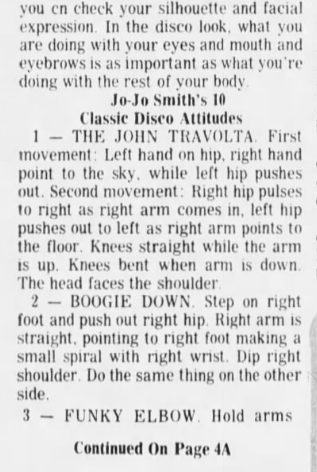
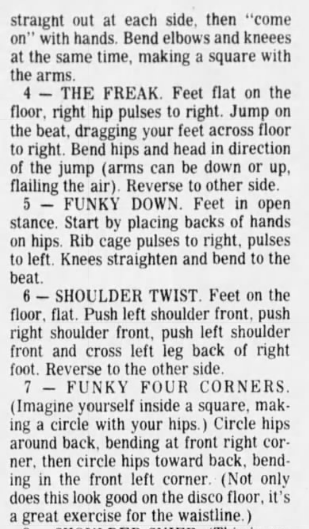
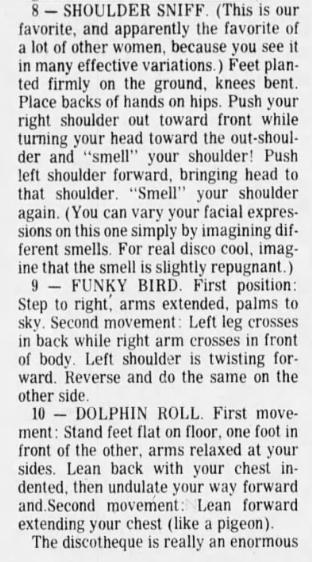
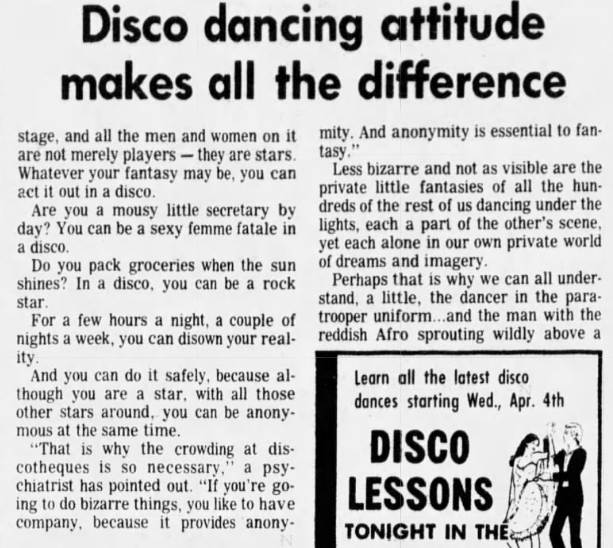
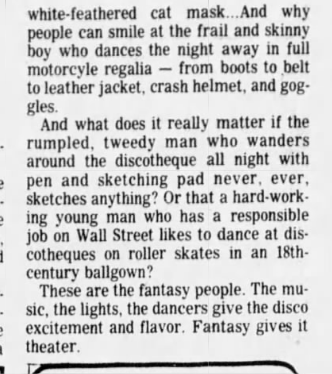
Source: The Times Herald (Port Huron, Michigan) 04 Apr 1979, Wed Page 1
I love the names of these moves, especially "Funky Elbows" and "Shoulder Sniff."
For some reason I am reminded of this classic video.
Posted By: Paul - Fri Jun 04, 2021 -
Comments (4)
Category: Hoaxes and Imposters and Imitators, Self-help Schemes, 1970s, Dance
Think Toy Safety
1974: The Consumer Product Safety Commission had to destroy eighty thousand buttons it had printed urging people to "think toy safety" after the buttons themselves were deemed unsafe.The problems with the buttons included sharp edges, lead-based paint, and pins that could be swallowed by children.
Digging deeper into the story, the irony lessens somewhat. It turns out that the problems were identified by the Commission itself because it had followed its own advice and tested the buttons before distributing them.

York Daily Record - Nov 16, 1974
Posted By: Alex - Wed Jun 02, 2021 -
Comments (3)
Category: Toys, Regulations, 1970s
Ice Pick Lobotomies
An ice pick lobotomy involves inserting an ice pick above the eyeball and hammering it into the brain to destroy the frontal lobes. In 1977, the CIA admitted that it had considered doing this to enemy agents as a way to erase their memory following interrogation. This secret program was code-named "Project Artichoke".However, the agency insisted that by 1972 it had abandoned the idea as too barbaric, and too likely to "invite horrible reprisals".
Some other interrogation techniques that the agency had considered, but rejected, included:
—Shining flickering lights at a prisoner. "The analyst ... mentioned watching a restaurant fan which was too slow, but nevertheless spoiled his appetite."
—Injecting forms of cocaine into a suspect's brain through holes in the skull. "Too surgical for our use."
—Odors were also considered. The documents said that terror has been produced by exposing a subject to a harmless odor, such as geranium, simulating the smell of a lethal gas.
More info: cia.gov


Sacramento Bee - Oct 30, 1977
Posted By: Alex - Thu May 27, 2021 -
Comments (2)
Category: Spies and Intelligence Services, 1970s, Brain Damage

| Who We Are |
|---|
| Alex Boese Alex is the creator and curator of the Museum of Hoaxes. He's also the author of various weird, non-fiction, science-themed books such as Elephants on Acid and Psychedelic Apes. Paul Di Filippo Paul has been paid to put weird ideas into fictional form for over thirty years, in his career as a noted science fiction writer. He has recently begun blogging on many curious topics with three fellow writers at The Inferior 4+1. Contact Us |




